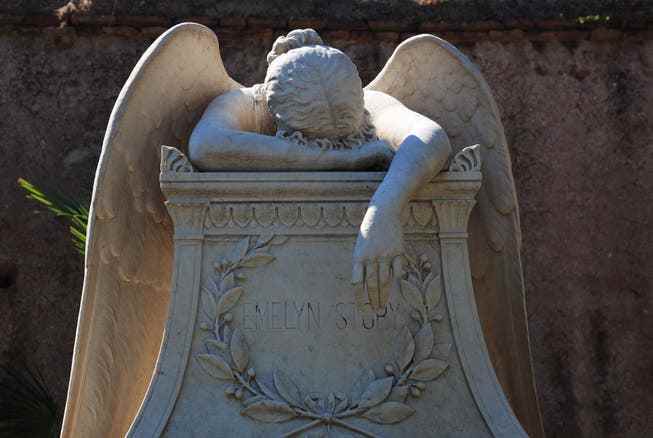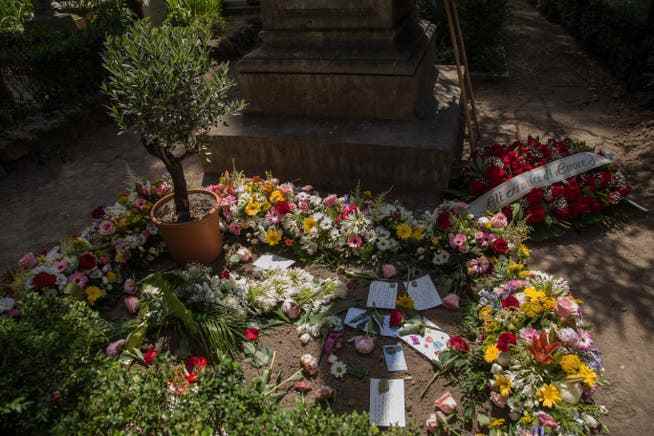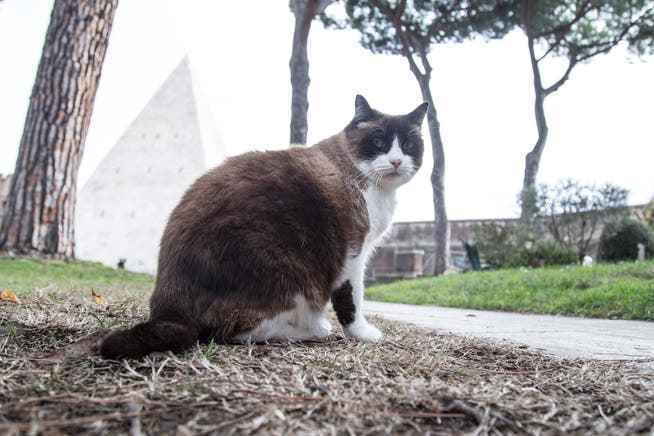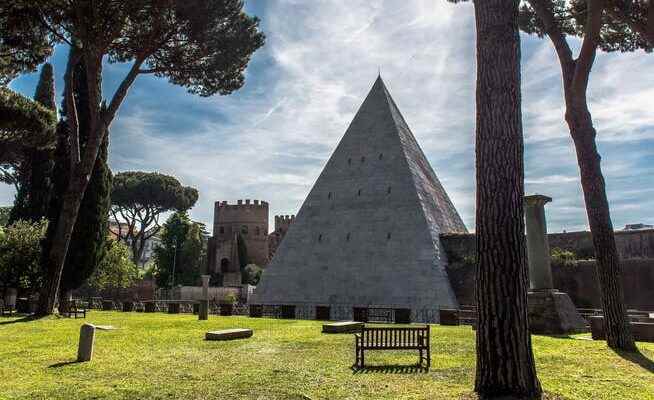Rome is deserted and sweltering hot these August days. A visit to a special burial ground in the Testaccio district promises a little cooling off. It tells exciting stories.
View of the Pyramid of Gaius Cestius from Cimitero Acattolico.
If you enter through the inconspicuous lattice gate and turn left, you think you are in England for a moment: A green area opens up, with some weathered gravestones and old stone slabs, sprawling trees that provide some shade. A churchyard, it could also be somewhere in Dorset or Surrey – if it weren’t for this strange pyramid, if it weren’t for the chirping of the cicadas and above all: if it weren’t for these huge pine trees, which with their beguiling scent are reminiscent of an overgrown dune on the Mediterranean . Not England, then, but Rome.
Exactly Testaccio, a quarter just outside the city center. Here is something unique, a place of refuge on hot days, a place of silence: the Cimitero Acattolico, the cemetery for non-Catholic foreigners. It has also been called the Cemetery of the Heretics or «luogo dove si seppelliscono i protestanti», i.e. the place where the Protestants are buried.

One of the many beautiful tombstones in the famous Roman cemetery.
Northern Europeans, English, German, Swiss
Here are the romantic poets John Keats and Percy Bysshe Shelley, here are August von Goethe, Gottfried Semper, Antonio Gramsci and Andrea Camilleri – poets, thinkers, architects, artists, adventurers, entrepreneurs. Members of the originally Greek jewelery dynasty Bulgari found their final resting place here, as did the Swiss hotelier family Wirth, the Lenzburg composer Fanny Hünerwadel and the former features editor of this newspaper, Hanno Helbling.
Between 5,000 and 6,000 people have been buried here over the course of its more than 300-year existence, and around 2,500 graves can be visited today. The cemetery along the Aurelian city wall has long since been expanded, and it covers a much larger area than that described at the beginning. The atmosphere, of course, has remained unique.
“One might fall in love with death when one is buried in so lovely a place,” Shelley wrote in 1821 at the funeral of his poet friend John Keats. Little did he know that a year later he would be lying there himself. Shelley drowned in the Gulf of La Spezia when she was only 30 and was buried in Rome.
With Andrea Camilleri

“A lot of incredible stories intersect here,” says art historian Amanda Thursfield, director since 2008 of the Cimitero. For her services to the cemetery, she was inducted into the Order of the British Empire by the British Queen in 2022, an honor she only mentions in passing, with British understatement. “Where do we want to sit down?” she asks, choosing a park bench opposite the resting place of the great Sicilian author Andrea Camilleri as the place for our conversation. A special place, there are fresh flowers on the grave, they must have just been laid by enthusiastic readers.
Certainly, many visitors come to the cemetery because of such celebrities, says Thursfield, but many unknown people have been buried here. “There are many very young among them, adventurers who had accidents or became ill during the Grand Tour,” she explains. The Grand Tour: This was the classic educational tour of the better sons and daughters of the European nobility and the upper bourgeoisie. It lasted several months, led to the most important art sites in Europe and Italy, such as Florence, Venice, Naples and Rome, and was intended to give the young travelers the final touches in their education.

The grave of the writer Andrea Camilleri, who died in July 2019, shortly after his funeral on the Acattolico.
tears of happiness
For some it ended in death, and the tombs on Cimitero Acattolico tell their stories. Sometimes descendants travel to Rome to linger at the graves of their ancestors who died tragically or to look for traces of their family history. Recently she met a man who was in tears because he had finally found an uncle’s grave. “They were tears of happiness,” Thursfield recalls.
The fact that this cemetery exists at all has to do with the history of the city of Rome, especially with the fact that the seat of the Catholic Church is located here. Those who did not profess Catholicism could not be buried in Rome, let alone cremated. People of other faiths were buried, along with people who, in the eyes of the church, had “fallen” like prostitutes or robbers.
When the Stuarts from England and Scotland went into exile in the first decades of the 18th century and finally found refuge in the Papal States, Pope Clement XI came. In embarrassment. Because many members of the court of the Catholic King James III. were Protestants and notable figures. And as such, they claimed a proper burial.
In accordance with a request from the royal court, Clemens finally allowed the use of a burial ground within the city walls, near the ancient pyramid of Gaius Cestius. This was a high Roman official who had a huge tomb built between 18 and 12 BC. This is where the Protestants should now be able to be laid to rest. And the Cestius pyramid today serves as a kind of monumental signpost to the Cimitero Acattolico.
Cats are included
Today’s cemetery was created on the side facing the city. Incidentally, the zone around the pyramid is also home to numerous cats, which roam between flowering bushes and doze on the warm grave slabs. Like the numerous sculptures and statuettes, they are one of the special features of this place. The Union I gatti della pyramide takes care of the four-legged friends.

Even the cats love the cemetery in the Roman district of Testaccio.
The questions that Amanda Thursfield deals with are sometimes very prosaic in nature. Just recently, a huge branch from an old pine tree broke off after a gust of wind, damaging part of the Aurelian Walls. Now Thursfield has to negotiate with the city about the repairs, her facial expressions reveal that the city bureaucracy is not an easy conversation partner. But the director, it seems, knows all the ins and outs of the Eternal City. She has lived in Rome for 43 years and speaks perfect Italian with a slight British accent. She will retire this winter, the job has already been advertised.
It’s a challenging task. Over the years, it has proved helpful that the “General Committee”, a body of fourteen embassies, including the Swiss supports the management and is at your side with advice and action.
The Cimitero is a private institution, income comes from the grave concessions and the – voluntary – entrance fees that are collected at the entrance. Until 25 years ago the Cimitero was closed to the public. Thursfield has always advocated a cautious opening – no easy task in a tourist hotspot like Rome. If there are many visitors, this is good for the cash register, but harms the cemetery.
exceptional phenomena
“We don’t want to be a tourist attraction,” says Thursfield firmly, “but an actively used cemetery.” In other words: a place that primarily serves its actual purpose, but on the other hand is also open to life, to sympathetic curiosity about all the stories it holds. She probably prefers visitors like the man with reading glasses who is sitting on a park bench and leafing through a thick tome with relish. An idyllic picture.
It is late afternoon, at 5 p.m. soft music is coming from loudspeakers, telling visitors to leave the site. One is reluctant to leave the quiet place, outside the noisy city awaits.
But wait, one more question: why is Camilleri actually located here? That was an Italian! Well, maybe he was an atheist or an agnostic, but certainly not a foreigner. Amanda Thursfield smiles and says: “The regulations allow exceptions.” One of them makes it possible for illustrious Italians to be laid to rest here. However, they must be artists of international standing.
